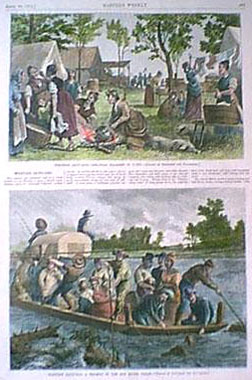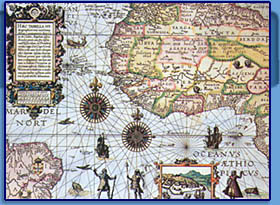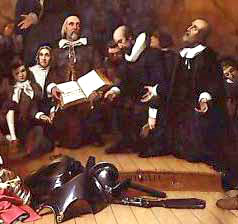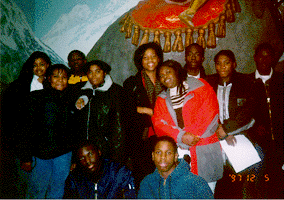|
● Racial Problems
● Poverty
● Drug Abuse
● Crime
● The Abuse of Power
by Government and Corporations
Text
Racial Problems
 |
|
Early Immigrants Arrviving in the New World
|
 Unlike
most other peoples, Americans are primarily a nation of immigrants.
The citizens or their ancestors immigrated from many parts of the
globe—some as refugees from religious and political persecution,
some as adventurers from the
Old World seeking a better life, some as captives
brought
to America against their own will to be sold into slavery.
Though people all share a common American culture, the
nation contains many racial and ethnic subcultures with their own
distinctive characteristics. These differences might
seem trivial
or irrelevant
to outside observers, but they have contributed
to racial conflicts that have been a persistent social problem to
American society. Unlike
most other peoples, Americans are primarily a nation of immigrants.
The citizens or their ancestors immigrated from many parts of the
globe—some as refugees from religious and political persecution,
some as adventurers from the
Old World seeking a better life, some as captives
brought
to America against their own will to be sold into slavery.
Though people all share a common American culture, the
nation contains many racial and ethnic subcultures with their own
distinctive characteristics. These differences might
seem trivial
or irrelevant
to outside observers, but they have contributed
to racial conflicts that have been a persistent social problem to
American society.
 |
|
The Slave Trade Routes
|
 |
| The white Anglo-Saxon
Puritans |
 The
United States was founded on the principle of human equality, but
in practice the nation has fallen far short of that ideal.
American society is a stratified
one, in which power, wealth, and prestige
are unequally distributed
among the population. This inequality is not simply a matter of
distinctions between social classes; it tends to follow racial and
ethnic lines as well, with the result that class
divisions often parallel racial divisions. The first
settlers from "Anglo-Saxon" northern Europe quickly took
control of economic
assets and political power in the United States, and
they have maintained this control, to a greater or lesser degree,
ever since. Successive
waves of immigrants from other parts of Europe and elsewhere in
the world have had to struggle long and hard to become assimilated
into the mainstream of American life. Some have succeeded and have
shared in the "American
dream"; others notably those whose ethnic or racial
characteristics differ most markedly from those of the dominant
groups have been excluded by formal
and informal barriers from full participation in American
life . The result of this discrimination has been a severe and continuing
racial tension in the United States that has periodically erupted
into outright
violence. Particularly since the civil rights demonstrations, ghetto
riots,
and other unrest in the 1960s, race
and ethnic relations have been a major preoccupation
of
social scientists, politicians and the general public. The
United States was founded on the principle of human equality, but
in practice the nation has fallen far short of that ideal.
American society is a stratified
one, in which power, wealth, and prestige
are unequally distributed
among the population. This inequality is not simply a matter of
distinctions between social classes; it tends to follow racial and
ethnic lines as well, with the result that class
divisions often parallel racial divisions. The first
settlers from "Anglo-Saxon" northern Europe quickly took
control of economic
assets and political power in the United States, and
they have maintained this control, to a greater or lesser degree,
ever since. Successive
waves of immigrants from other parts of Europe and elsewhere in
the world have had to struggle long and hard to become assimilated
into the mainstream of American life. Some have succeeded and have
shared in the "American
dream"; others notably those whose ethnic or racial
characteristics differ most markedly from those of the dominant
groups have been excluded by formal
and informal barriers from full participation in American
life . The result of this discrimination has been a severe and continuing
racial tension in the United States that has periodically erupted
into outright
violence. Particularly since the civil rights demonstrations, ghetto
riots,
and other unrest in the 1960s, race
and ethnic relations have been a major preoccupation
of
social scientists, politicians and the general public.
 In
the United States, any group other than the dominant white
Anglo-Saxon Protestant majority is a minority group in American
society. These racial and ethnic minorities mainly refer to the
blacks, Native Americans or American Indians, the Hispanics, and
Asian Americans. The social and economic conditions of Native Americans
are probably worse than those of any other minority groups. All
these racial groups including Asian
Americans are still suffering from racial discrimination
and injustice. But here we look more closely at one of them whose
problems have attracted the most public attention: the blacks or
Afro-Americans. In
the United States, any group other than the dominant white
Anglo-Saxon Protestant majority is a minority group in American
society. These racial and ethnic minorities mainly refer to the
blacks, Native Americans or American Indians, the Hispanics, and
Asian Americans. The social and economic conditions of Native Americans
are probably worse than those of any other minority groups. All
these racial groups including Asian
Americans are still suffering from racial discrimination
and injustice. But here we look more closely at one of them whose
problems have attracted the most public attention: the blacks or
Afro-Americans.
 The
largest of the racial and ethnic minorities in the United States
is the blacks, who number over 25.2 million, or 11.7% of the population.
Their history in the United States has been one of sustained
oppression, discrimination, and denial of basic civil rights and
liberties. The
largest of the racial and ethnic minorities in the United States
is the blacks, who number over 25.2 million, or 11.7% of the population.
Their history in the United States has been one of sustained
oppression, discrimination, and denial of basic civil rights and
liberties.
 The
first blacks were brought to North America in 1619. Within a few
decades the demand for their cheap labor led to a massive
slave trade that ultimately transported some 400 000 Africans to
this continent. Captured by neighboring tribes in their native villages
and then sold to white traders, the slaves were shipped in wretchedly
crowded conditions to the
Caribbean and then to the United States, where they were
sold like cattle
at auctions.
The
myth of their racial inferiority—their
irresponsibility, promiscuity,
laziness
and lower intelligence as assiduously
propagated
as
a justification
for
their continued subjugation. The
whip
or
the lynch
mob
served
to assert
social
control over slaves who challenged the established order. The
first blacks were brought to North America in 1619. Within a few
decades the demand for their cheap labor led to a massive
slave trade that ultimately transported some 400 000 Africans to
this continent. Captured by neighboring tribes in their native villages
and then sold to white traders, the slaves were shipped in wretchedly
crowded conditions to the
Caribbean and then to the United States, where they were
sold like cattle
at auctions.
The
myth of their racial inferiority—their
irresponsibility, promiscuity,
laziness
and lower intelligence as assiduously
propagated
as
a justification
for
their continued subjugation. The
whip
or
the lynch
mob
served
to assert
social
control over slaves who challenged the established order.
 The
Northern states had all outlawed
slavery by 1830, but the Southern states, in which slaves had become
the backbone
of the economy, maintained the institution until
it was finally ended by the
Civil War, Lincoln's
emancipation
of
slaves in 1863, and the 13th Amendment to the Constitution in 1865.
But even after the abolition of slavery, wholesale
discrimination was practiced against black Americans. Many
states passed segregation
laws
to keep the races apart in schools, housing, restaurants, and other
public facilities, and institutionalized discrimination kept blacks
in the lowest-paid jobs. A variety of methods, such as
rigged
"literacy" tests, were used to keep blacks off
the voters' rolls and thus prevent them from exercising their political
rights. Segregation
laws continued to be enforced in Southern states until the 1950s;
in the North informal methods were used—often just as effectively. The
Northern states had all outlawed
slavery by 1830, but the Southern states, in which slaves had become
the backbone
of the economy, maintained the institution until
it was finally ended by the
Civil War, Lincoln's
emancipation
of
slaves in 1863, and the 13th Amendment to the Constitution in 1865.
But even after the abolition of slavery, wholesale
discrimination was practiced against black Americans. Many
states passed segregation
laws
to keep the races apart in schools, housing, restaurants, and other
public facilities, and institutionalized discrimination kept blacks
in the lowest-paid jobs. A variety of methods, such as
rigged
"literacy" tests, were used to keep blacks off
the voters' rolls and thus prevent them from exercising their political
rights. Segregation
laws continued to be enforced in Southern states until the 1950s;
in the North informal methods were used—often just as effectively.
 |
| Black pride |
 The
1960s saw the great civil rights movement whose goals were
to end segregation laws completely and fight for the equal rights
for the colored people. Many American blacks began to have a new
mood. They had feelings of pride; they declared that "black
is beautiful"; and the black community showed signs of unprecedented
self-confidence. Equally important, many black leaders began to
disclaim
full integration
into the American mainstream as the goal of the black minority.
Instead, they argued, blacks ought to coexist with other groups
in a plural society containing different and distinctive communities
living in mutual respect. The
1960s saw the great civil rights movement whose goals were
to end segregation laws completely and fight for the equal rights
for the colored people. Many American blacks began to have a new
mood. They had feelings of pride; they declared that "black
is beautiful"; and the black community showed signs of unprecedented
self-confidence. Equally important, many black leaders began to
disclaim
full integration
into the American mainstream as the goal of the black minority.
Instead, they argued, blacks ought to coexist with other groups
in a plural society containing different and distinctive communities
living in mutual respect.
 The
current status of black Americans presents a mixed picture. The
elimination
of legal barriers to their advancement
has been a major gain, but institutionalized discrimination is still
rife.
Housing in particular, remains highly segregated: the great majority
of blacks continue to live in neighborhoods that are overwhelmingly
black, and most whites live in neighborhoods that are overwhelmingly
white. Busing
and other programs aimed at integrating the schools have had some
impact in inner-city areas but have made virtually no difference
to the segregation that exists between predominantly black urban
centers and the predominantly white suburbs and small towns that
surround them. Blacks have achieved considerable educational
gains; black enrollment in colleges rose spectacularly between The
current status of black Americans presents a mixed picture. The
elimination
of legal barriers to their advancement
has been a major gain, but institutionalized discrimination is still
rife.
Housing in particular, remains highly segregated: the great majority
of blacks continue to live in neighborhoods that are overwhelmingly
black, and most whites live in neighborhoods that are overwhelmingly
white. Busing
and other programs aimed at integrating the schools have had some
impact in inner-city areas but have made virtually no difference
to the segregation that exists between predominantly black urban
centers and the predominantly white suburbs and small towns that
surround them. Blacks have achieved considerable educational
gains; black enrollment in colleges rose spectacularly between
 |
|
Black Student Association on Campus
|
1966, when 4.6% of college students
were black, and 1976, when 10.7% were black. Median
family income of blacks rose from $3230 in 1960 to $10142 in 1977,
but the median income of white families rose at least as fast, and
the income gap between the two groups has widened in recent years.
A major source of this differential
is the fact that
blacks tend to be barred
from
positions of authority over other workers, and are restricted instead
to lower-paying jobs further down the work-place hierarchy.
This
factor alone accounts for about a third of the total black-white
income gap. The political influence of blacks is increasing,
both in the South, where they are voting in unprecedented numbers,
and in the major cities of the North, Midwest, and West, where they
are a major voting bloc
and, in some cases, a majority.
 Race
relations between black and white still leave much to be desired,
although there is unmistakable evidence of some improvements in
attitudes. However, there is a sharp divergence between the
races on the question of how much progress has been made in ending
discrimination. The majority of whites believe that there has been
a lot of progress in getting rid of discrimination, but more than
half of the blacks felt that there has not been much real change.
Only less than 20% of the whites believe that many blacks miss
out on jobs and promotion in their city because of discrimination.
Many blacks are still pessimistic about progress in race
relations. Race
relations between black and white still leave much to be desired,
although there is unmistakable evidence of some improvements in
attitudes. However, there is a sharp divergence between the
races on the question of how much progress has been made in ending
discrimination. The majority of whites believe that there has been
a lot of progress in getting rid of discrimination, but more than
half of the blacks felt that there has not been much real change.
Only less than 20% of the whites believe that many blacks miss
out on jobs and promotion in their city because of discrimination.
Many blacks are still pessimistic about progress in race
relations.
 One
reason for the difference in the perceptions of the two groups may
be that blacks are more acutely aware that a great many of their
members have failed to share in the more general gains made by blacks
since the 1960s. Over the past decade many blacks, perhaps as many
as a third, have worked their way into the middle class, in the
process often moving from the ghetto to the suburbs or to better
housing within the cities. But other blacks have been left behind,
and urban
ghettos now contain a permanently impoverished
"underclass"
of habitually unemployed or underemployed black people.
Many members of this "underclass" are young and unskilled.
They live in cities where the unemployment rate for teenage black
workers runs as high as 50%, or about 8 times the rate for the American
work force as a whole. This
"underclass" could continue to persist, even in the absence
of racial discrimination, in much the same way as other pockets
of poverty persist—that is, for reasons of social-class inequality.
In any event, such progress as has been made in the past decade
has brought no benefit whatever to the black "underclass."
Living in an environment of poverty, decay, crime, drug addiction,
joblessness, and hopelessness, this ghetto underclass offers an
explosive potential for the future. One
reason for the difference in the perceptions of the two groups may
be that blacks are more acutely aware that a great many of their
members have failed to share in the more general gains made by blacks
since the 1960s. Over the past decade many blacks, perhaps as many
as a third, have worked their way into the middle class, in the
process often moving from the ghetto to the suburbs or to better
housing within the cities. But other blacks have been left behind,
and urban
ghettos now contain a permanently impoverished
"underclass"
of habitually unemployed or underemployed black people.
Many members of this "underclass" are young and unskilled.
They live in cities where the unemployment rate for teenage black
workers runs as high as 50%, or about 8 times the rate for the American
work force as a whole. This
"underclass" could continue to persist, even in the absence
of racial discrimination, in much the same way as other pockets
of poverty persist—that is, for reasons of social-class inequality.
In any event, such progress as has been made in the past decade
has brought no benefit whatever to the black "underclass."
Living in an environment of poverty, decay, crime, drug addiction,
joblessness, and hopelessness, this ghetto underclass offers an
explosive potential for the future.
Previous Page Next
Page
|

